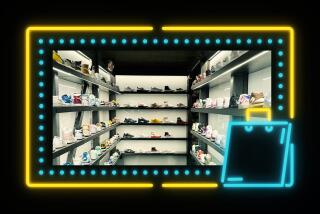Haven for Those Who Want to Run a (Model) Railroad : Hobbies: N.Y. store that caters to model train enthusiasts offers thousands of items, ranging in price from 25 cents to $10,000.
- Share via
NEW YORK — Here on a layover from Germany, Peter Nanz got hit on the head by a train.
“Hey!” Nanz cried as the tiny engine fell off a shelf at the Red Caboose, the only store in Manhattan dealing exclusively in model trains.
Every inch of the store’s 1,500 square feet is crammed with hundreds of thousands of model trains and accessories. Boxes brimming with tiny bottles of paint lie in the aisles, and drawers explode with miniature bolts, screws and bulbs. Signs, engines, tracks and toys dangle from the ceiling, and a plate on the floor awaits a cat slumbering somewhere in the rubble.
One customer who regularly comes to peruse the magazines scattered on the floor and stuffed into racks said as he rummaged through a disorderly stack, “It’s a challenge, but I have years of experience doing it.”
“I’ve never seen so many trains,” Jerry Tipton said to his son, Mark, as they moved past hundreds of minuscule passenger cars and engines. “Some of them I’ve never even seen before.” But instead of a $30 locomotive, Mark bought a scenery magazine for $4.95.
Because enthusiasts can spend a little or a lot on this hobby it is extremely popular. The Model Railroad Industry Assn. says the half a million model railroaders in the United States spend between $10 and several hundred dollars a month on the hobby and reports a 415% increase in sales of model railroad equipment in the last 10 years.
That’s good news to Alan Spitz, the store’s owner, because he carries the very cheap to the outrageously expensive. When an elderly customer asked about a particular engine, Spitz scampered from behind his cluttered counter to display the $1,500 brass locomotive.
“We have nuts and bolts for a quarter,” Spitz said when the customer moved on, “and a Hudson engine that is $10,000 because it is a collector’s item from the ‘40s. And everything in between is equally as important.”
As knowledgeable as he is about model railroading, Spitz is sometimes less than polite. He reportedly brushed off one shopper seeking an inexpensive item as a “nickel-and-dime customer.”
“My friends tell me I have a personality for mail-order,” he said. “Sometimes my patience is a bit shortish--and being a New Yorker, why not?”
But many other customers have only praise for both curmudgeon and store.
“He knows everything and he’s got it all,” said Ronald Docksal from Reston, Va., who shops at the Red Caboose when he’s in New York on business. “It’s the only place to come.”
Spitz and a few friends started selling model trains from the back of a hardware store around 1970. His friends, he said, “gradually drifted away and left me with the albatross.”
He opened his own store, on West 45th Street, in the early ‘70s and watched it grow. During what Spitz called “the flush Reagan go-go years,” he grossed $1.7 million a year. With the recent recession, that figure has leveled out at $1 million a year. In 1988, he hired a company to take his inventory, but it gave up in frustration. It did, however, leave him a 1,200-page partial list of his items and estimated their value at $800,000. Spitz says his current stock is much larger, and he now offers services such as locomotive painting and in-home scenery design and construction.
It is his enormous stock that keeps the customers coming. In fact, Spitz says, customers are his best advertisers.
“I’ve known Alan for 25 years,” said Mike Masino, who specializes in subway trains and makes a weekly trip to the Red Caboose. “He’s got new products coming in all the time. He must have 300 different engines in the N scale alone in different varieties, in different colors. A hobby store will carry only two or three.”
Spitz’s stock attracts out-of-town and foreign business as well. In the late ‘80s he began advertising worldwide shipping in three hobby magazines. Now the phone never stops ringing and he ships to Italy, France and Portugal. Mail-order sales account for 40% of his business.
But walk-in customers make up the other 60% of his business, and though many of them live in apartments, they have adapted a potentially space-hungry hobby to the confines of city life.
Rita McMahon, a marketing researcher shopping for a tunnel, said her son’s trains run on the back of a panel that folds down from the wall like a Murphy bed.
“Isn’t that ingenuity?” she said.
West 45th Street used to house three model-train stores, but now that his last competitor across the street closed, Spitz plans to move the Red Caboose into the larger space. He said he hopes that a street-level storefront will attract more customers and added that he may expand his stock and his mail-order business.
But as one Red Caboose customer observed, it is difficult to believe there is anything the store doesn’t already stock.
“It’s marvelous! It’s a museum!” exclaimed Michael Bieger, a German customer, as he pressed his face close to glass cases lined with trains that could fit in the palm of his hand.
More to Read
Sign up for The Wild
We’ll help you find the best places to hike, bike and run, as well as the perfect silent spots for meditation and yoga.
You may occasionally receive promotional content from the Los Angeles Times.






